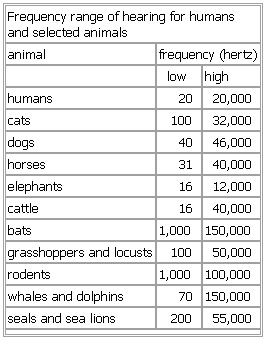Frequency range of hearing for humans and selected animals
- Frequency range of hearing for humans and selected animals
-
Frequency range of hearing for humans
and selected animals
low high
humans 20 20,000
cats 100 32,000
dogs 40 46,000
horses 31 40,000
elephants 16 12,000
cattle 16 40,000
bats 1,000 150,000
grasshoppers and locusts 100 50,000
rodents 1,000 100,000
whales and dolphins 70 150,000
seals and sea lions 200 55,000
See as table:
* * *
Universalium.
2010.
Look at other dictionaries:
ultrasonics — /ul treuh son iks/, n. (used with a sing. v.) the branch of science that deals with the effects of sound waves above human perception. [1930 35; see ULTRASONIC, ICS] * * * Vibrational or stress waves in elastic media that have a frequency above… … Universalium
Hearing impairment — See also: Deaf culture for the social movement.. Deaf and/or hard of hearing Classification and external resources The International Symbol for Deafness … Wikipedia
Radio-frequency identification — (RFID) is a technology that uses radio waves to transfer data from an electronic tag, called RFID tag or label, attached to an object, through a reader for the purpose of identifying and tracking the object. Some RFID tags can be read from… … Wikipedia
Health and Disease — ▪ 2009 Introduction Food and Drug Safety. In 2008 the contamination of infant formula and related dairy products with melamine in China led to widespread health problems in children, including urinary problems and possible renal tube… … Universalium
sound — sound1 soundable, adj. /sownd/, n. 1. the sensation produced by stimulation of the organs of hearing by vibrations transmitted through the air or other medium. 2. mechanical vibrations transmitted through an elastic medium, traveling in air at a… … Universalium
Sound — /sownd/, n. The, a strait between SW Sweden and Zealand, connecting the Kattegat and the Baltic. 87 mi. (140 km) long; 3 30 mi. (5 48 km) wide. Swedish and Danish, Oresund. * * * I Mechanical disturbance that propagates as a longitudinal wave… … Universalium
Life Sciences — ▪ 2009 Introduction Zoology In 2008 several zoological studies provided new insights into how species life history traits (such as the timing of reproduction or the length of life of adult individuals) are derived in part as responses to… … Universalium
nervous system, human — ▪ anatomy Introduction system that conducts stimuli from sensory receptors to the brain and spinal cord and that conducts impulses back to other parts of the body. As with other higher vertebrates, the human nervous system has two main… … Universalium
Cat — For other uses, see Cat (disambiguation) and Cats (disambiguation). Domestic cat[1] … Wikipedia
attention — attentional, adj. n. /euh ten sheuhn/; interj. /euh ten shun /, n. 1. the act or faculty of attending, esp. by directing the mind to an object. 2. Psychol. a. a concentration of the mind on a single object or thought, esp. one preferentially… … Universalium

